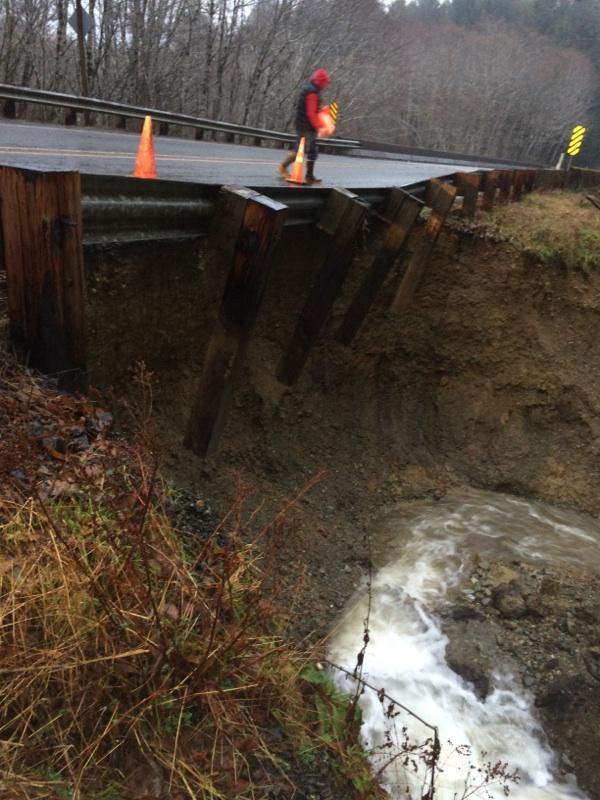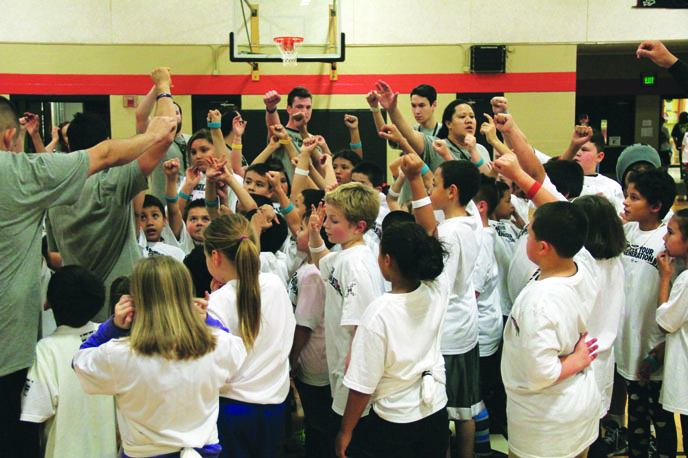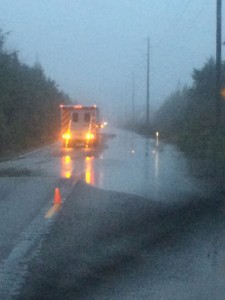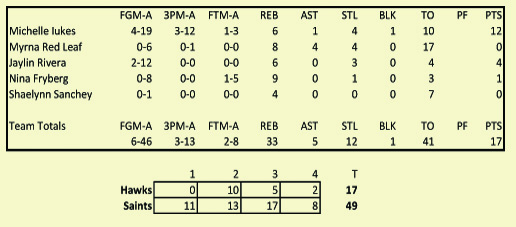Endangered newborn baby orca is a girl, experts say

By Associated Press and KOMO News Staff
The Center for Whale Research in Washington state says the baby, part of the J pod of the southern resident orca population, has stayed healthy since it was first spotted Dec. 30 off the Canadian Gulf Islands of British Columbia.
The newborn whale is being called J-50. Researchers say they are now working with Canada’s Department of Fisheries and Oceans to gather more information about the baby’s mother.
Experts originally identified a whale in her early 40s known as J-16 seen swimming alongside the calf as its mother, but now say she might have actually been looking after the newborn for her daughter – a 16-year-old orca called J-36.
If J-16 is the mother, she will be the oldest southern resident orca to give birth in more than four decades of field studies.
Southern resident killer whales are considered an endangered species, with just 78 in the waters of British Columbia and Washington state, including the new arrival. But the arrival of the newborn orca is considered an encouraging sign following the death earlier this month of a pregnant killer whale from the same group.
Now, everyone is hoping J-50 survives. An estimated 35 percent to 45 percent of orcas die in their first year, said Howard Garrett of the Whidbey Island-based Orca Network.
Roads Reopen, Flood Cleanup Underway In Western Washington

Fawn Sharp Quinault Indian Nation
By Tom Banse, NW News Network
Grays Harbor County commissioners approved an emergency declaration for their coastal county Tuesday in the wake of flooding and landslides.
Damage assessment and cleanup is underway in half a dozen river basins around Western Washington.
The disaster declaration in hard-hit Grays Harbor County gives officials greater flexibility to pay for response and recovery. They can move money around expeditiously and waive certain contracting and bidding requirements.
In Aberdeen and Hoquiam — and beyond to Chehalis and Snoqualmie — business owners and residents started the messy cleanup of flooded ground floors now that floodwaters have mostly receded. Highway crews reopened at least one lane of traffic on most of the major roads leading to and from the coast.
Meanwhile, Washington Department of Natural Resources geologist Dave Norman urged people living near steep slopes “to stay vigilant.” A landslide risk lingers probably until the weekend given how saturated some soils are.
There are still no reports of serious injuries from the landslides or the localized flooding. The Washington State Patrol reported one driver suffered minor injuries when a car and two trucks hit boulders that fell onto Interstate 90 a few miles east of Snoqualmie Pass early Tuesday morning.
The westbound lanes of the freeway were closed for much of the day as WSDOT engineers assessed the hillside above the roadway. The agency then placed concrete jersey barriers along the right shoulder of the freeway to stop any more rocks from rolling into the traffic lanes.
Secretary Jewell Celebrates Agreement with Seminole Tribe of Florida to Help Spur Investment, Commercial Development
Tribal leasing regulations foster economic development, represent another step furthering tribal self-determination
Source: U.S. Department of the Interior
HOLLYWOOD, Fla. – As part of President Obama’s commitment to empowering American Indian and Alaska Native tribal nations and strengthening their economies, Secretary of the Interior Sally Jewell and Bureau of Indian Affairs Director Michael Black today joined Seminole Tribal Chairman James E. Billie to formally approve tribal leasing regulations that will help spur investment and commercial development on the Seminole Tribe’s reservations.
Upon approval of the tribal regulations by the Department of the Interior, tribes may approve land leases without Bureau of Indian Affairs (BIA) approval, fostering tribal self-governance in the approval of leases for homes and small businesses in Indian Country.
“The Seminole Tribe of Florida will now decide for itself how it wants to do business on its lands – from making it easier for families to buy and build houses to opening businesses in the communities where they have lived for generations,” said Secretary Jewell, who also serves as chair of the White House Council on Native American Affairs. “Today’s agreement will encourage economic development and help create jobs while strengthening tribal sovereignty and self-determination by putting these decisions back in the hands of the tribe.”
Today’s signing ceremony comes on the heels of the White House Tribal Nations Conference held in December 2014, when leaders from all 566 federally recognized tribes were invited to Washington, D.C. to interact directly with the President and senior cabinet and administration officials. The conference – the sixth for the Obama Administration – continues to build on the President’s commitment to strengthen the government-to-government relationship with Indian Country.
“This is an important day for the Seminole Tribe, which will be able to process residential and business leases without the need for BIA approval,” said Chairman Billie. “This authority will allow the Tribe to better serve its members and create new opportunities for economic development on the Tribe’s reservations. We appreciate the Department’s assistance in working with the Tribe through the approval process.”
“Tribal self-determination means the tribe will now decide how its lands may be used for the good of its members and how it wants to do business on its lands,” said BIA Director Black. “The Seminole Tribe’s endeavors contribute to the local, state and regional economies and the tribe’s leasing initiative will further that economic vitality and contribution.”
Tribal council members and several tribal government officials joined Secretary Jewell, Director Black and Chairman Billie during a signing ceremony this morning at Seminole Tribal Headquarters in Hollywood, Florida.
The Seminole Tribe of Florida resides in communities located on six component reservations: Big Cypress, Brighton, Fort Pierce, Hollywood, Immokalee and Tampa. The Tribe expects to use its new authority for business, residential and biomass energy development, as well as for cultural, educational, recreational, spiritual, and other purposes.
Under the Helping Expedite and Advance Responsible Tribal Homeownership Act (HEARTH Act), signed by President Obama in July 2012, federally recognized tribes may develop and implement their own laws governing leasing of federal tribal trust lands for residential, business, renewable energy and other purposes. The law provides that such tribes may lease their lands without federal approval, promoting greater investment in tribal communities and job creation, both of which support tribal self-determination.
The Secretary’s action today brings to 15 the number of federally recognized tribes with leasing regulations approved under the HEARTH Act. An additional 14 tribes have HEARTH Act applications under current review or modification. A full list of approved regulations and additional information about the HEART Act is available HERE.
The HEARTH Act complements a parallel effort Interior undertook to overhaul the BIA regulations that govern its process for approving surface leases on lands the federal government holds in trust for Indian tribes and individuals. As trustee, Interior manages about 56 million surface acres in Indian Country.
The new regulations were finalized in December 2012 and represent the most comprehensive reform of the BIA’s antiquated leasing process. The new regulations fundamentally change the way the BIA does business, providing clarity by identifying specific processes – with enforceable timelines – through which the BIA must review leases. The regulation also establishes separate, simplified processes for residential, business, and renewable energy development, rather than using a “one-size fits all” approach that treats a lease for a single family home the same as a lease for a large wind energy project.
Nike N7 ignites a Tulalip Move Moment

Photo/Micheal Rios
By Micheal Rios, Tulalip News
During this past fall season Nike N7 ignited a series of ‘move moments’ across tribal and aboriginal communities in North America and Canada. Tulalip was among the very select few chosen to participate in the Nike N7 event. In all there were seven communities selected, three in Canada (Siksika, Six Nations of the Grand River First Nation, and the Aboriginal Friendship Center) and four in the United States (Gila River Indian Community in Arizona, Inter Tribal Sports in California, a Native Urban Center in Oklahoma, and the Tulalip Tribes).
“Tulalip was a community that we picked a few months ago. Every time we release product we like to do an event within the Native community,” Tessa Sayers, Nike N7 Product Specialist, explains. “The latest Nike N7 holiday collection product is inspired by coastal design. We worked with an artist named Peter Boome, a Salish artist, and he worked with our Nike designers to focus on a collection that was inspired by coastal design. When we were picking communities we could only pick one community in Oregon or Washington, and partly why we chose Tulalip is because you have a Nike Factory Store where we sell Nike N7 product. So I called and spoke with Tori Torrolova (Athletic Director for the Tulalip Boys and Girls Club) who said ‘Absolutely, we are game. Bring the event to us.’”
The goal of the N7 Move Moments is to inspire and enable youth to be physically active. They look a lot like mini-camps, but the Nike brand calls them ‘move moments’ because it is a moment in time they are getting the youth active and participating in a sport. This year the events were basketball themed, last year it was soccer. Bringing basketball into our community in an fun and energizing way that will inspire participants to move themselves and their generation is all part of the Nike N7 philosophy. N7 is inspired by Native American wisdom of the Seven Generations: In every deliberation we must consider the impact of our decisions on the seventh generation.

Photo/Micheal Rios
Nike originally planned to have the N7 Move Moment in Tulalip at the Boys and Girls Club during the month of November, but decided to push the date back in the wake of the Marysville Pilchuck High School shooting. Pushing the date back several weeks was part of Nike N7’s plan to make the event much more impactful for the Tulalip youth.
“Everybody on the N7 staff and our media group are all Native American and this stuff we are naturally passionate about,” Sayers says. “When we heard about the unfortunate incident that happened out here it was not something we had to think about, we called Tori and arranged to come out and actually put on the event with you guys and make it a bigger thing, so we can really bring something positive and uplifting to the Tulalip community. The other six communities had their ‘move moments’ on their own, but we decided to come up and bring our own trainers and put on the event for Tulalip. It was a no brainer for N7.”
Unlike the N7 Move Moments that were held at the other six Native and aboriginal communities chosen, Tulalip was given twice as much product and equipment in order to allow up to 160 youth to participate. To further add to the significance for Tulalip the Nike N7 team personally delivered the product, spoke to our youth, and brought along a 12 person training crew to engage with our youth while participating in the activities.
Tulalip’s very own specialized N7 Move Moment, titled ‘Move Your Generation’ was held Monday, December 15, 2014 at the Tulalip Boys and Girls Club from 4:30 p.m. to 8:00 p.m. Youth who participated in the event were provided with plenty of Nike N7 freebies upon entry. Nike N7 wrist bands, stickers, and t-shirts were among the free merchandise.
An estimated ninety 5-12 year-olds and thirty 13-18 year-olds, for a grand total of 120 Tulalip community youth, were inspired and enabled to be physically active while participating in the premium and energetic basketball experience.

Photo/ Micheal Rios
The Tulalip youth were treated to a 10 minute warm-up session by nationally certified strength and conditioning coach and trainer at Nike World Headquarters, Henry Barrera. Following the warm-up session the kids were broken up into five groups where they would alternate between 5 mini-camp stations, each one lasting 10 minutes.
The ball skills station taught basketball-specific skills, like alternating dribbles between both hands, basics of a crossover, and then a quick dribble into a crossover. The training cones station taught body control and body mechanics by having kids quickly change directions in a 5-10-5 agility drill. The mini-bands station taught stability and body control by placing a mini-band around the ankles and having participants perform a series of movements all the while stepping and stabilizing with each movement. The speed rope station taught rhythm, body control and coordination. Lastly, the agility balls station taught athletic stance and body control.
A special workshop was also added to the mix when Nike N7 decided to put on the event for Tulalip. Nike made it possible for Jillene Joseph, Executive Director of the Native Wellness Institute, to spend an hour with each age group (5-12 and 13-18). In her workshop Joseph promoted well-being through a series of activities that embrace the teachings and traditions of our Native American ancestors.
“We know your community is grieving and healing at this time therefore we wanted to bring you an uplifting, fun and energetic experience. We hope you leave here feeling invigorated, refreshed, inspired and motivated to take leadership among your community,” said Sam McCracken, GM for Nike N7, to all the Tulalip youth and community members present.
Adding to the already youth impacting event, N7 surprisingly held a check ceremony in their evening wrap up. Boys and Girls Club executive staff members Chuck Thacker and Tori Torrolova were presented with a $10,000 grant award from the N7 Fund to the Tulalip Boys and Girls Club. The money will help support the club’s athletic program says Torrolova. “Those funds I’m hoping to use to benefit our coaches, volunteers and people who constantly work with the program. Making sure kids are fed when we have home games and away games and snacks to take with us. All this money I want to concentrate on the athletic programs that we run here on a yearly basis.”
After the N7 Move Moment was over, Torrolova took a moment to reflect on the evening’s activities, “I think it turned out great and all the kids had a blast. They saw different ways of moving and using different types of equipment all the while everything was being tied to basketball. We received so much brand new basketball equipment thanks to Nike N7. Now, our staff and coaches have access to that equipment will use it for future practices and activities.”

Photo/Micheal Rios
Micheal Rios, mrios@tulaliptribes-nsn.gov
Grounding Yourself in Uncertain Times
Do you have things that are weighing you down from last year, the year before, the years before that?
There is a new group at Tulalip to help you work through some of those issues, perhaps some grief, frustration, confusion, all the feelings one has when things happen in life that leave you off center.
This is a drop in group, open to the Tribal Community
Use of the Word ‘Redskins’ By Announcers Drops; Pundit Predicts Sale of Team in 2015
Timothy Burke of Deadspinreportedthat announcers said the word 472 fewer times in the 2014-15 regular season.
Meanwhile, use of the word ‘Washington’ to identify the team slightly increased during broadcasts. In 2014, ‘Washington’ was mentioned 1,390 times. In 2013, it was mentioned 1,380.
The team itself has been mired in controversy over its use and defense of its name. In June, the U.S. Patent and Trademark Office stripped the team of six of its seven trademarks, finding the word to be “disparaging to Native Americans.”
Since then, a growing chorus of dignitaries, celebrities and former players have called on team owner Dan Snyder to change the name. Former Secretary of State and possible 2016 presidential hopeful Hillary Clinton called the team name “insensitive”, and even President Barack Obama said if he were the owner of the team he would consider changing the name.
Snyder said he will “NEVER” change the name.
On Dec. 28, The Washington PostAssociate Editor Bob Woodward predicted on FOX News Sunday that Snyder will sell the team this year to either Apple or Google.
“Danny Snyder, the owner of the Redskins, who’s had past success in business, will realize he’s part of the problem,” he said, “and he’s going to sell it; he’s going to sell the Redskins and the bidding war is going to be between Apple and Google. Think of it — the ‘Washington Apples’?”
Read more at http://indiancountrytodaymedianetwork.com/2015/01/06/use-word-redskins-announcers-drops-pundit-predicts-sale-team-2015-158585
Floods, Heavy Rains Take Toll at Quinault, Emergency Declaration Issued
Moclips Highway Flooding “Worst Ever Seen”
Source: Press Release Quinault Indian Nation

TAHOLAH, WA (1/5/15) – The Quinault Indian Nation has issued a Declaration of Emergency due to extreme rainfall over the past two days which has caused numerous landslides, culvert failures and washouts on the Quinault Reservation. The QIN Property Management Division has ordered an emergency inspection of all the Tribe’s buildings and infrastructure and major access roads into the Tribe have either been closed or are considered extremely hazardous, said QIN President Fawn Sharp.
“The Moclips Highway 109 Bridge near Quinault Village, a main access road to and from Nation has been washed out and closed. That is a major problem for the Tribe,” she said.
“The Moclips River flooding is the worst I’ve seen it. If it is bad as it looks, SR 109 could take days to repair. And if our own Moclips Highway needs major repairs we will have significant commuter problems,” said Sharp.
She added that the Moclips River is flowing over its banks one mile south of the Moclips Highway. For safety reasons SR 109 in Moclips has been closed. “The river has claimed at least two vehicles. One belonged to a Quinault elder and was left abandoned on the highway in the flood. An unknown number of other tribal members who live adjacent to the River were evacuated at midnight last night and are now taking refuge at the Quinault Beach Resort and Casino in Ocean Shores. This section of SR 109 is closed until further notice. SR 109 is very treacherous for motorists currently due to standing water and debris caused by the flooding,” she said.
According to sources in Queets the sewer treatment plant was compromised by the Queets River which overflowed its banks. It is unsure whether or not the sewer plant is non-operational or if the service road is damaged beyond repair at this time. This plant is being monitored closely by the Nation’s managers. This breach has not been verified at this time.
The Nation highly recommends that drivers stay away from the beaches as an alternative route. The surf is up and even at low tide beach driving is not safe.
Our very own Community Services Director, Michael Cardwell, is clearing storm drain covers. The Nation’s responders have been out in force, working hard at everything from clearing drains to evaluating damage, said Sharp. “We are very happy and relieved to report that, to our knowledge, there has been no loss of life or injury caused by this heavy rain and flooding,” she said.
Reports regarding landslides and flooding have come in from across the county, including closures at the Aberdeen Bluff on State Route 12, U.S. 101 at mile marker 73, US 101 S of Ocean Beach Road, State Route109 , the State Route 109 bypass, Wishkah Road at mile marker 6 and numerous streets in Aberdeen and Hoquiam.
Concerns remain high as tribal emergency personnel are on duty checking conditions, rendering aid where necessary and cooperating and coordinating with other jurisdictions. The deluge has also borne down on the Chehalis River where warmer weather is turning snow to rain in the mountains and a flood watch has been issued by the National Weather Service. Quinault Nation retains treaty protected rights on the Chehalis. There, as in many places, habitat modifications by various industries over the years have diminished the popular desire for watersheds to flood within their natural floodplains, and many of the fixes and proposed fixes only make matters worse, she said.
“The good news is that the rainfall is expected to diminish this evening and is not likely to return until Friday. But it is important for people to remain alert for potential slides, lingering flood dangers and infrastructure damage. Please, start this new year off safely,” said Sharp.
“I want to applaud the work done by those who have pitched in to help others during this time of need, particularly our Quinault staff members. They have been tireless and dedicated, a great example to everyone. That, too, is a great way to start the year 2015.”
Too Many Scholarships, Not Enough Native Students Applying
In talking to my friend Al Paulson recently, it turned out we have a common problem. We can’t give away scholarships. What a shame.
In the modern age of computers, scholarships are everywhere, it seems. FastWeb, the most popular scholarship site, has over 1.5 million entries in its database. Other websites such as Scholarships.comhave similar numbers. But it’s hard to give them away, let me tell you. I have been doing it for 42 years, and we never have enough applicants.
Al Paulsen who lives in St. Paul, Minnesota founded Marketplace Productions 20 years ago. After he had some success in business, he and other members of the Minnesota American Indian Chamber of Commerce decided to launch an Indian scholarship program. But for almost a decade now, he has had trouble getting Native American studentsto apply for it.
Paulsen has worked with casinos and business development on Indian reservations for over 30 years now. His mother was a LaDuke from White Earth before she married his father Albin Paulsen. So Al is a first cousin of the famous Indian activist Winona LaDuke. He says his mother got hooked on his father because he was a member of a band that played in the local area.
They lived north of White Earth and farmed for a few years, and then moved to the Twin Cities. Albin got a job in the Ford plant and worked there until he retired. Al got a job at Ford after he finished high school, but the hard work convinced him he needed to go to college. He became one of the early White Earth citizens to finish college.
He picked St. Cloud State University(SCSU) because they had a great hockey team and he wanted to play. The Minnesota Chippewa Tribe (MCT) gave him a scholarship; without it, he says, he would not have been able to go to college. “Without that grant,” he told me, “I don’t know if I could have afforded to complete my college degree.” He finished in 1966, and is now in the SCSU Hall of Fame as a hockey player.
He was the first LaDuke to finish college, and Winona was the second. “By the end of my sophomore year,” he said, “I realized that educationwas a great equalizer, so I got serious about college and graduated in four and a half years.” He made the varsity hockey team as a freshman, and is still the only Indian ever to play hockeyfor St. Cloud State.
He paid for his first year himself, from work at Ford and from a rice business he had set up. But the scholarship from MCT paid his tuition for the rest of his college.
Al is also an enthusiastic volunteer, and has been for 20 years. “I am an instructor at Indian schools for Junior Achievement as my way of paying back for what the tribe did for me in paying for my tuition and books and assisting me in getting my college degree,” he told me. “I am also on the Diversity Council for MNSCU, the Minnesota State College and University board, overseeing 42 state colleges and tech colleges in Minnesota.”
“We talk a lot about retention rates and graduation rates, comparing all ethnic minorities with all the others and the caucasian student rates. There is a big difference in rates, with white students and Asian students having the best rates…and us Indians having the lowest rates. From our state, it appears the rates for Indian students are improving.”
The Indian Chamber, which he chaired for awhile, set up a scholarship fund several years ago to give two scholarships of copy,500 each to two students. They wanted to give them to students with business majors, but got so few applicants that they opened it to students with any major. And they still get only a handful of applicants.
I told him about some of my experiences trying to get Indian students to apply for scholarships. I was in Holbrook, Arizona 10 years ago to try to recruit Indian students for our scholarship.
We encourage students to apply not only for ours, but for every scholarship they can find. These days, that is 40 or more. We had a student from Laguna Pueblo four years ago, Isaiah Rodriguez, who found 102 scholarships—which is still our highest total. We have been going since 1986. The national record is still 200, which a black girl from Macon, Georgia accomplished in 1991. Her name is Marianne (Angel) Ragins, and she is now “Miss Scholarship.” She has written three books about how to win scholarships. Our reservation school libraries do not have these books.
As I talked to the students at Holbrook, I told them they should find all the local scholarships as well, such as Lions, Elks, Rotary, Moose, and so on. The counselor at Holbrook High School, Dean McNamee, whose daughter is one of our grads, piped up and said, “Yes, the Elks had four scholarships last year, and no one applied for them.”
That makes me sad. I hate to see any scholarship not be awarded. I know there is a student somewhere, maybe an Indian student, who could use that scholarship.
For four straight years, I visited one high school on the Navajoreservation to recruit students. But one day my assistant asked me why I was going there. “How many applicants have we gotten from there?” she asked.
I had to admit, “None.” She said, “Why are you going there every year?” I haven’t been back. But old hard headed here will probably go back this year. We have to talk to 100 students to get two to apply.
I know the high schools are not preparing Indian students for college. In a research project I did 15 years ago, fewer than 10 percent of Indian students had taken the courses in high school they needed to be ready for college.
Fewer than 10 percent had taken four years of English. Fewer than 10 percent had taken four years of science. Fewer than 10 percent had taken four years of math, including Algebra I, Algebra II, Geometry, and Trigonometry. Fewer than 5 percent had taken Calculus. If they go to college, they are going to have to take remedial classes, which is a real let down to the Indian valedictorian who was the BMOC (Big Man on Campus) in high school. Some of them never get over the humiliation. Is it any wonder that our dropout ratefor Indian college students is over 80 percent?
High school preparation for college is an excellent research project for a graduate student, by the way. I just finished reviewing dozens of articles and books for my next book, and there is very little research on the high school preparation of Indian students for college. The little that is there is surprising, sometimes. For instance, traditionalism has little to do with college success, according to one article. Another article reports that high GPA students drop out about as often as low GPA students, which is frustrating.
In the research I did, the average number of scholarships Indian students applied for was one. That is, most Indian students did not apply for any scholarships; they rely totally on federal financial aid. Then every twentieth student applied for 10 or 20 scholarships, bringing the average up to one.
Granted the scholarship application process is a little difficult. You should know what you are going to major in, and what you are going to do after graduation. But the rewards are huge. I tell students they should win all the scholarships they can, and if they have more than they need for college, they should give their momma money. And I mean it. Few students do that, but they should. And they can start their retirement with it if they want to.
There is a national scholarship group that was formed 15 years ago. It is an association of college and private scholarship people. I went to the first or second meeting, and several people told me they wanted to get applications from Indian students. “We never get an application from an Indian student,” they told me.
God bless Al Paulsen and the other people who are trying to run scholarship programs. Don’t give up, boys and girls. We need to develop all the talent we can in Indian country.
Dr. Dean Chavers is director of Catching the Dream. Founded in 1986, CTD awards scholarships to high potential Indian college students. It also works to improve Indian schools. His next book will be called “The American Indian Dropout.” It will be published in early 2013. He has written books on Indian leaders, racism in Indian country, exemplary Indian schools, and how to write winning proposals in the past 40 years.
Read more at http://indiancountrytodaymedianetwork.com/2012/09/01/too-many-scholarships-not-enough-native-students-applying-132188
Lady Hawks lose to Lopez Island, 13-61

by Micheal Rios, Tulalip News
The Tulalip Heritage Lady Hawks (0-9) hosted the Lopez Island Lobos (4-2) on Tuesday, January 6. This would be the second meeting of the season for these two teams; the first was played at Lopez Island where the Lobos won 56-20.
From the opening possessions it was apparent that the Lady Hawks would be in for a very challenging game. The Lobos were applying a full court defense and double teaming guard Michelle Iukes, the team’s offensive leader, whenever she would bring up the ball. Moving the ball with accuracy when they are going against heavy ball pressure has been a season long struggle for the Lady Hawks. For what seemed like the entire 1st quarter the Lady Hawks were under duress trying to move the ball against the Lobos press defense. When the quarter came to an end the Lady Hawks had committed 15 turnovers and were trailing 0-20.
In the 2nd quarter the Lobos ball pressure continued to frustrate the Lady Hawks. The turnovers continued to come as errant passes were resulting in easy buckets for the Lobos. Coach Cyrus “Bubba” Fryberg called a timeout to tell his players to focus on executing good solid, chest passes and that the offense would immediately get better once they started making better passes. Shortly thereafter guard Myrna Red Leaf scored the first Lady Hawks bucket of the game, with an assist from center Nina Fryberg. The passes were improving but the quick handed Lobos guards were still finding ways to come up with steals, forcing 10 Lady Hawk turnovers in the quarter. Going into halftime the Lady Hawks trailed 2-37.
During the halftime intermission the Lady Hawks were urged to not pay attention to the scoreboard. Even though they were trailing the focus would be getting better as a team and making better passes. Defensively they were urged to hustle, hustle, and hustle.
The 3rd quarter was a total team effort by the Lady Hawks that displayed their desire to improve as a team and not to focus on the scoreboard. They hustled back on every time they were on defense, they got their most rebounds of the game, and they made sure every Lobos’ shot was a contested one. Offensively, the Lady Hawks cleaned up on their passing by making straight-line passes and making sure each other were in good position before making a pass. By doing so the Lady Hawks cut their turnovers down and had much more time to setup their offense. With the crowd and their coach urging them the offense started to come. Forward Mikaylee Pablo assisted on fellow forward Jaylin Rivera’s basket to give the Lady Hawks their second made field goal. Then, with 0:13 to go in the quarter guard Michelle Iukes pulled up and hit a 3-pointer. Going into the 4th quarter the Lady Hawks trailed 7-41, but with their effort on both sides of the ball they had managed to win the 3rd quarter by outscoring the Lobos 5-4.
In the final quarter the Lobos caught fire and the Lady Hawks weren’t able to carry over their defense intensity from the 3rd quarter. The Lobos went on a 20-0 run to put the game well out of reach, but just as they have done all season, the Lady Hawks continued to fight until the end. In the final thirty seconds the Lady Hawks nearly doubled their point total when first Michelle scored a 3-pointer and then on the very next possession, Myrna pulled up from just inside half-court and swished a 3-pointer to beat the final game buzzer. The Lady Hawks lost 13-61, but showed a winner’s mentality by playing until the final buzzer.
Micheal Rios, mrios@tulaliptribes-nsn.gov












